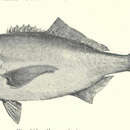Diagnostic Description
(
Inglês
)
fornecido por Fishbase
Uniformly dark to black.
- licença
- cc-by-nc
- direitos autorais
- FishBase
- Recorder
- Cristina V. Garilao
Life Cycle
(
Inglês
)
fornecido por Fishbase
In Australia, spawning appears to be correlated with water temperature and nutrient upwellings (Ref. 7129). It appears that mature fish move up the continental slope into shallow depths (320-400 m) and aggregate in specific grounds for spawning (Ref. 6390).There is no information on the number of eggs blue eye produce nor on the egg and larval stages of their life history (Ref. 6390).
- licença
- cc-by-nc
- direitos autorais
- FishBase
Morphology
(
Inglês
)
fornecido por Fishbase
Dorsal spines (total): 7 - 8; Dorsal soft rays (total): 19 - 21; Analspines: 3; Analsoft rays: 15 - 17
- licença
- cc-by-nc
- direitos autorais
- FishBase
- Recorder
- Cristina V. Garilao
Trophic Strategy
(
Inglês
)
fornecido por Fishbase
Generally, blue eye remain close to the sea bed during the day and move up in the water column at night, following concentrations of food (Ref. 6390). The fish are found over rough ground and at the edges of canyons and steep drop-offs. Blue eye appear to prefer cold water as part of their general behaviour (Ref. 6390).Juveniles inhabit surface waters, sometimes in association with floating debris (Ref. 6390). Fish move to the deeper demersal habitat at about 2 years of age when 47-50 cm long (Ref. 7128).
- licença
- cc-by-nc
- direitos autorais
- FishBase
Biology
(
Inglês
)
fornecido por Fishbase
Most common over or near rocky areas at 100-300 m (Ref. 9258). Generally, blue eye remain close to the sea bed during the day and move up in the water column at night, following concentrations of food (Ref. 6390). The fish are found over rough ground and at the edges of canyons and steep drop-offs. Blue eye appear to prefer cold water as part of their general behavior (Ref. 6390). Juveniles inhabit surface waters, sometimes in association with floating debris (Ref. 6390). Feed primarily on the pelagic tunicate Pyrosoma atlantica which is found near the sea bed during the day but dispersed throughout the water column at night (Ref. 7129, 30454). They also feed on squid, mollusks and crustaceans (Ref. 30455, 30454) and fish ranging from small lanternfish (Myctophidae) to large fish such as gemfish (Rexea solandri). Juveniles consume small planktonic and sedentary organisms (Ref. 30456). Marketed fresh and frozen; exported to Japan for sashimi; eaten steamed, fried, broiled and baked (Ref. 9988).
- licença
- cc-by-nc
- direitos autorais
- FishBase
Importance
(
Inglês
)
fornecido por Fishbase
fisheries: commercial
- licença
- cc-by-nc
- direitos autorais
- FishBase

